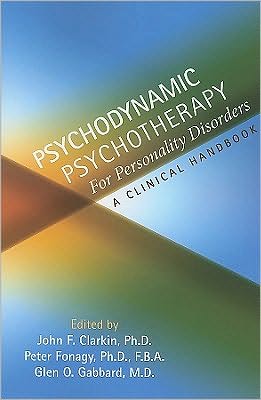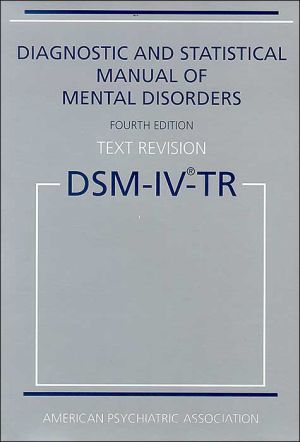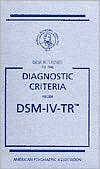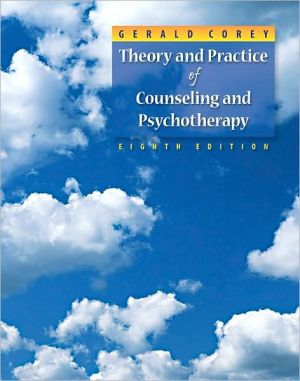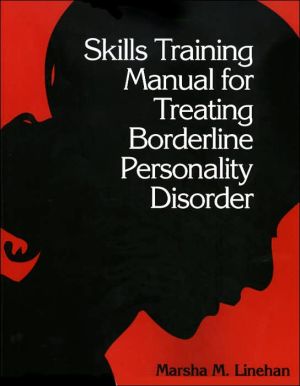Psychodynamic Psychotherapy for Personality Disorders: A Clinical Handbook
This well-documented and articulate manual gathers in one place the psychodynamic psychotherapy thinking and research on each of the Axis II personality disorders. Psychodynamic Psychotherapy for Personality Disorders: A Clinical Handbook includes the work of 22 contributing writers in addition to the three primary authors, John F. Clarkin, Ph.D., Peter Fonagy, Ph.D., and Glen O. Gabbard, M.D. Each contributor has extensive clinical experience, and some also have research experience, with the...
Search in google:
This handbook is intended for clinicians with a range of expertise who employ a psychodynamic orientation in the assessment and/or treatment of patients with personality pathology. Well documented and articulate, this manual is appropriate for everyone from students of psychotherapy to experienced clinicians seeking to refine their practice. Psychodynamic Psychotherapy for Personality Disorders: A Clinical Handbook gathers in one place the psychodynamic psychotherapy thinking on each of the Axis II personality disorders. This includes the work of 22 contributing writers in addition to the three primary authors, John F. Clarkin, Ph.D., Peter Fonagy, Ph.D., and Glen O. Gabbard, M.D. The material presented here is available elsewhere but, until now, not all in one place.The focus of the book is the psychodynamic conceptualization, assessment, and treatment of the personality disorders as currently described in the American Psychiatric Association’s Diagnostic and Statistical Manual of Mental Disorders, Fourth Edition, Text Revision (DSM-IV-TR). Included are 16 chapters in three sections: Defining Personality Pathology, Treatment Approaches, and Research for Future Directions. The background of models of personality and its pathology comprises Section I. Section II contains chapters on the treatment of specific personality disorder constellations. These treatment chapters provide information on the relevant empirical research, patient phenomenology and psychodynamics, treatment strategies, and techniques, woven together with clinical illustrations and vignettes. Section III includes a summary of the existing treatment outcome research and a glimpse of the diagnostic procedures in the near future. Each of the chapter authors has had extensive clinical, and sometimes research, experience with the assessment and treatment of one of the personality disorders described. Psychodynamic Psychotherapy for Personality Disorders: A Clinical Handbook is, as titled, a practical handbook and guide to clinicians with real-world applications. • Every patient a clinician treats has personality issues, if not a personality disorder. This book provides strategies and techniques for addressing personality issues• DSM-IV-TR is proceeding to DSM-V. This collection of papers provides up-to-date information on how the personality disorders will be handled in the upcoming DSM-V• The authors provide summaries of key concepts and suggested readings of particular value to residents and students in other disciplines The authors suggest that new research and reviews indicate, to the surprise of many, that psychodynamic treatments are effective for these personality disorders, and its impact is as great as, that of cognitive-behavioral treatments.
Preface. Part I: Personality Pathology: Defining the Focus of Intervention. An object relations model of personality and personality pathology. Attachment and personality pathology. Neurobiology of personality disorders. The Shedler-Westen assessment procedure: making personality diagnosis clinically meaningful. Part II: Psychodynamic Treatment Approaches. Psychotherapeutic treatment of cluster A personality disorders. Mentalization-based treatment and borderline personality disorder. Transference-focused psychotherapy and borderline personality disorder. Therapeutic action in the psychoanalytic psychotherapy of borderline personality disorder. Narcissistic personality disorder. Treatment of histrionic personality disorder. Psychodynamic treatment of antisocial personality disorder. Cluster C personality disorders: prevalence, phenomenology, treatment effects, and principles of treatment. Psychodynamic approaches integrated into day treatment and inpatient settings. Treatability of personality disorders: possibilities and limitations. Part III: Research and Future Directions. Evidence for psychodynamic psychotherapy in personality disorders: a review. Psychodynamic treatment planning and the official diagnostic system: toward DSM-5. Index.
\ Doody ReviewsReviewer: Benjamin Raatjes, MD (Rush University Medical Center) \ Description: After a summary of some basic principles of object relations theory, attachment theory, and neurobiology, this book discusses the possibility of combining clinical experience with more standardized measures when assessing personality pathology and explores therapeutic techniques applying these concepts.\ Purpose: The purpose is to reexamine psychodynamic treatments, keeping in mind recent studies suggesting their effectiveness in the treatment of personality disorders.\ Audience: This book is appropriate for mental health clinicians with expertise or interest in psychodynamic concepts. Students will find the review of several aspects of therapy to be helpful. More experienced clinicians may find details in their areas of expertise lacking, although they may benefit from an overview of areas in which they have less experience.\ Features: Authored by experts in their respective areas, the chapters can stand alone as a review of a particular theoretical framework or discussion of a clinical problem. Together, they give a general overview of psychodynamically oriented psychotherapy for personality disorders. Each chapter ends with a list of key clinical concepts and a small number of recommended readings. This book might benefit from a more thorough discussion of self-psychological concepts, especially in the section on narcissistic personality.\ Assessment: This is a useful book that provides an overview of key clinical concepts, reviews some areas of emerging research and interest, and suggests other books for a more detailed discussion of certain concepts. Though not exhaustive in its detail, it provides enough information to help readers generate questions that can be addressed in books with a narrower scope.\ \ \ \ \ From The CriticsReviewer: Benjamin Raatjes, MD(Rush University Medical Center)\ Description: After a summary of some basic principles of object relations theory, attachment theory, and neurobiology, this book discusses the possibility of combining clinical experience with more standardized measures when assessing personality pathology and explores therapeutic techniques applying these concepts.\ Purpose: The purpose is to reexamine psychodynamic treatments, keeping in mind recent studies suggesting their effectiveness in the treatment of personality disorders.\ Audience: This book is appropriate for mental health clinicians with expertise or interest in psychodynamic concepts. Students will find the review of several aspects of therapy to be helpful. More experienced clinicians may find details in their areas of expertise lacking, although they may benefit from an overview of areas in which they have less experience.\ Features: Authored by experts in their respective areas, the chapters can stand alone as a review of a particular theoretical framework or discussion of a clinical problem. Together, they give a general overview of psychodynamically oriented psychotherapy for personality disorders. Each chapter ends with a list of key clinical concepts and a small number of recommended readings. This book might benefit from a more thorough discussion of self-psychological concepts, especially in the section on narcissistic personality.\ Assessment: This is a useful book that provides an overview of key clinical concepts, reviews some areas of emerging research and interest, and suggests other books for a more detailed discussion of certain concepts. Though not exhaustive in its detail, it provides enough information to help readers generate questions that can be addressed in books with a narrower scope.\ \
